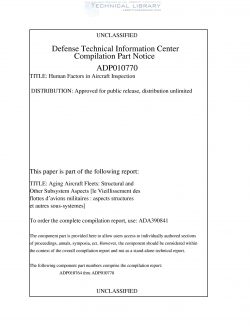DTIC-AD-P010770
- Version
- 211 Downloads
- 1.12 MB File Size
- 1 File Count
- March 5, 2017 Create Date
- March 5, 2017 Last Updated
Human Factors in Aircraft Inspection

1. Introduction: Inspection plays a critical role in airworthiness assurance. It is used as the detection system for required maintenance procedures and as a final check that the maintenance has been performed correctly. Inspection failure at either stage can compromise public safety. A critical defect may remain undetected and thus unrepaired, or on aircraft with a procedural enor (e.g. a missing lock-wire) may be released for service. These issues have been demonstrated in dramatic fashion in aircraft accidents. In 1988 an Aloha Airlines B- 737 aircraft suffered fuselage failure from undetected multi-site damage. In addition to aircraft structures, inspection errors have caused engine failures, for example the JT8-D failure on takeoff on a Delta flight from Pensacola in 1998. In both instances the inspection technique was technically capable of detecting the defect (a crack) but the overall system of technology-plus-human inspector failed. These incidents focused attention on the role of the human inspector in the technology-plus-inspector system. For many years (see Swain, 1990) human factors engineers had been quantifying human reliability using techniques derived from system safety. Fault tree analysis (FTA) and Failures Modes and Effects Analysis (FMEA) had been employed to determine how failures in the human components of a system affected overall system reliability. This set of techniques was first applied to aircraft inspection by Lock and Strutt (1985), who used their detailed task description of inspection to derive potential systems improvements. Two parallel lines of research also impact on improving human reliability in inspection. First, for many years it has been traditional to measure inspection system reliability in terms of the probability of detecting defects with specified characteristics under carefully controlled conditions. This set of techniques is used to define the inspection system capability, particularly for non-destructive inspection. The second research thread has been the on-going study of human factors in industrial and medical inspection. Early realization that industrial inspectors were not perfectly reliable led to many hundreds of studies aimed at modeling and improving inspection performance.
| File | Action |
|---|---|
| DTIC-AD-P010770 Human Factors in Aircraft Inspection.pdf | Download |

Comment On This Post